Spaghetti Bolognese recipe—just saying it evokes cozy kitchen aromas and hearty family dinners. For anyone who’s ever twirled a fork into rich, meaty pasta sauce and sighed with satisfaction, this guide is for you.
Before we get cooking, let me share a bit about us. Recipes Tasteful was born from one simple belief: anyone can cook magic in their home kitchen. Our founder, a former line cook-turned-recipe blogger, spent years testing and perfecting classics—from quick weeknight wins to authentic comfort food like this spaghetti Bolognese recipe. This blog is your go-to spot for real food, tested recipes, and culinary joy, all with no fluff or filler.
So today, we’re diving deep into what makes the best Bolognese recipe truly unforgettable. We’ll guide you from simple, humble ingredients to a dish bursting with robust Italian flavor. And yes, this isn’t just any meat sauce—this is our unique take that fuses traditional spaghetti Bolognese recipe roots, Jamie Oliver’s rustic flair, and even the structure of a Michelin star Bolognese recipe.
Expect this article to serve you:
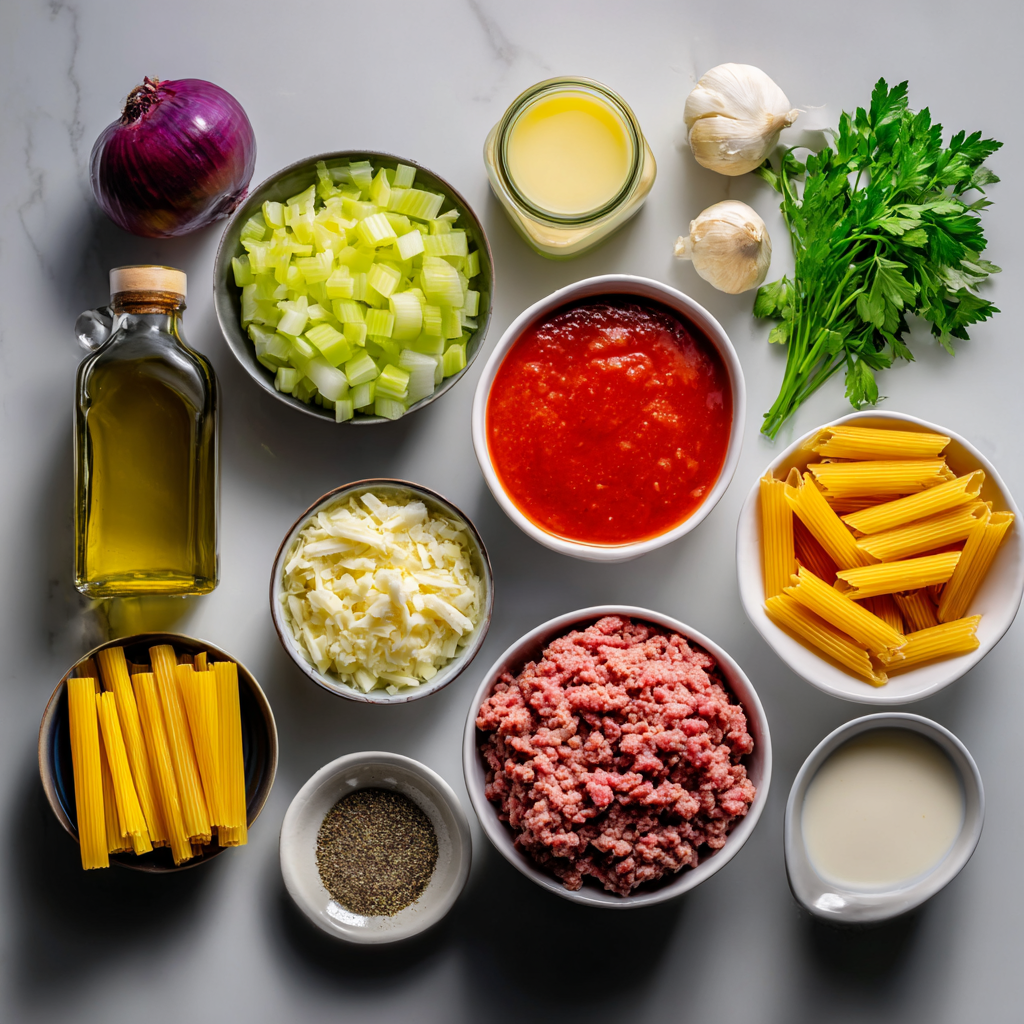 Browning meat is the first key step in building deep flavor
A classic spaghetti Bolognese recipe is built from simple ingredients, but don’t let that fool you. When used correctly, each one adds depth and richness. Let’s start with the essentials.
Browning meat is the first key step in building deep flavor
A classic spaghetti Bolognese recipe is built from simple ingredients, but don’t let that fool you. When used correctly, each one adds depth and richness. Let’s start with the essentials.
This combination rivals even a Michelin star Bolognese recipe, giving it the richness of restaurant-style sauce with easy home-cook execution.

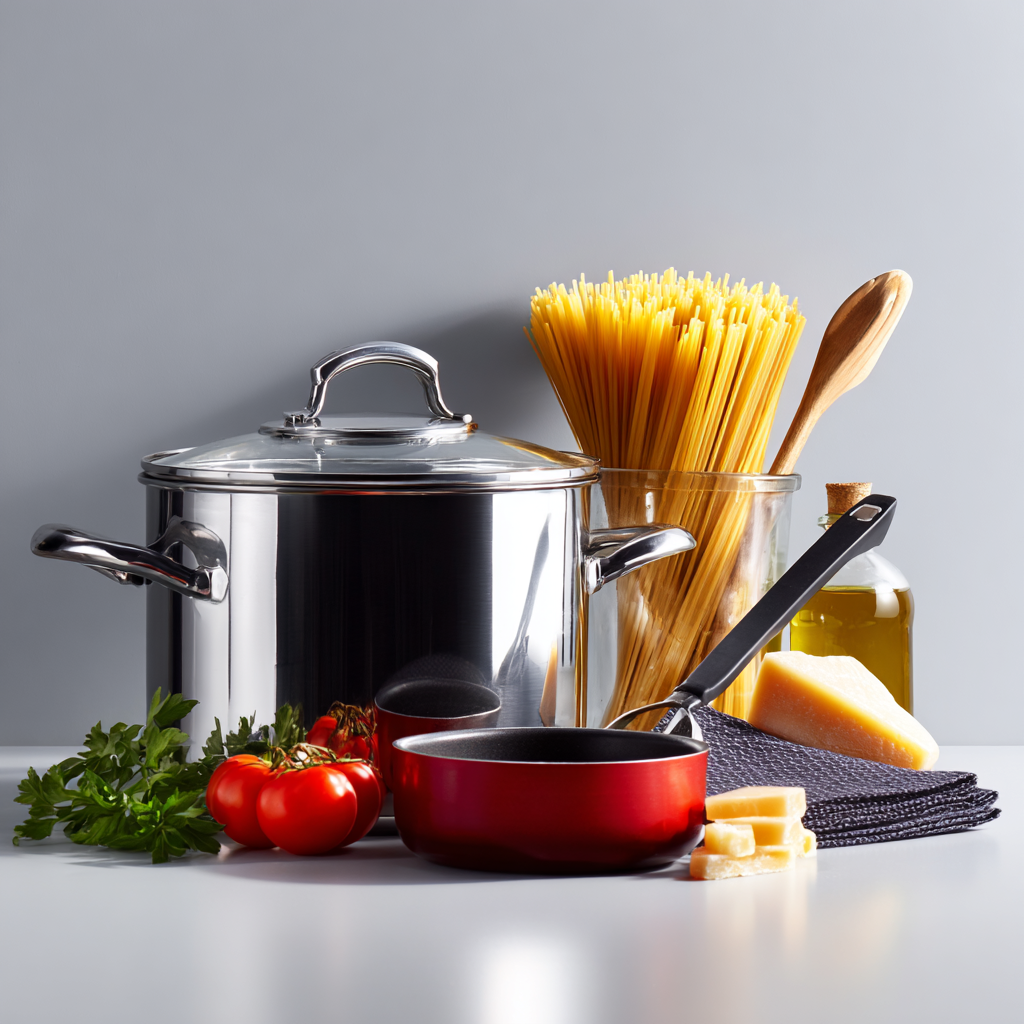
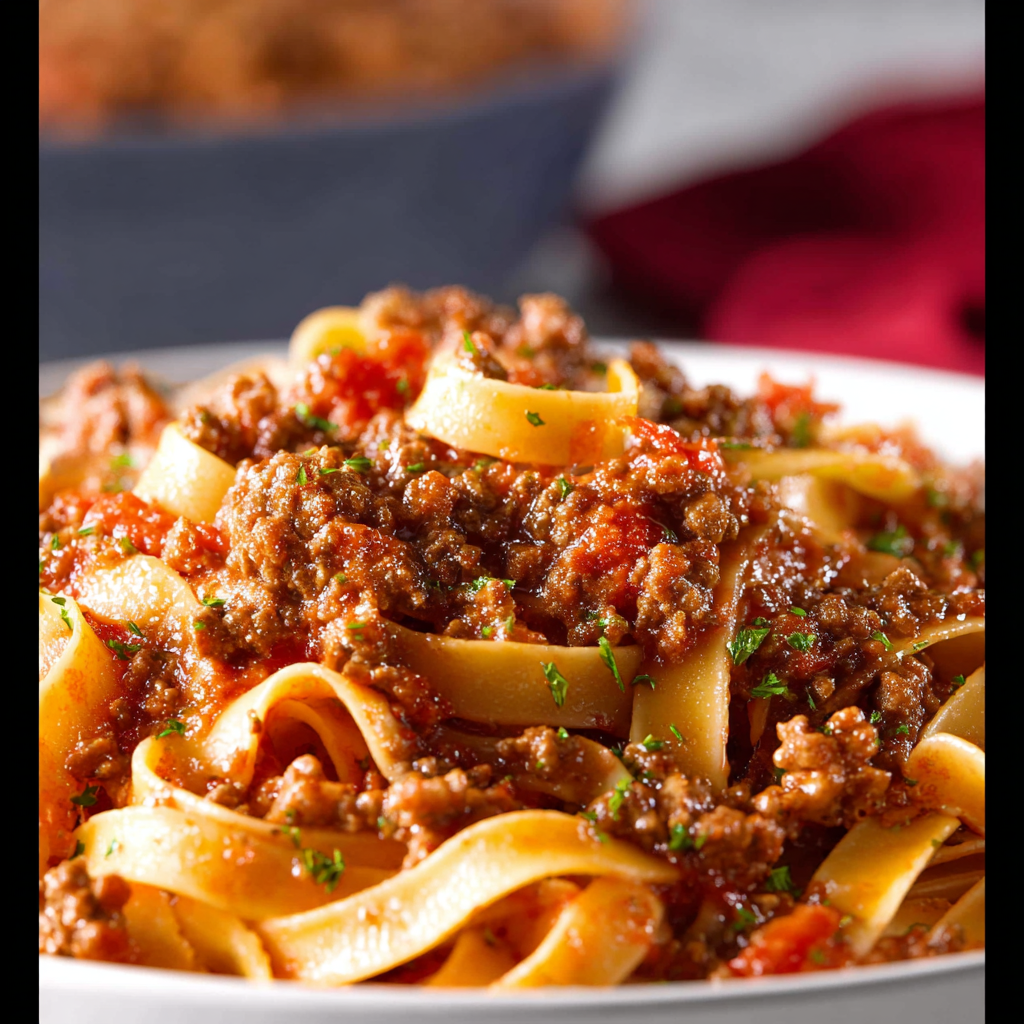 Store and freeze your Bolognese for quick weekday meals
Store and freeze your Bolognese for quick weekday meals
Try different shapes and notice how the wide noodles carry the sauce better, adding a richer mouthfeel to every bite.
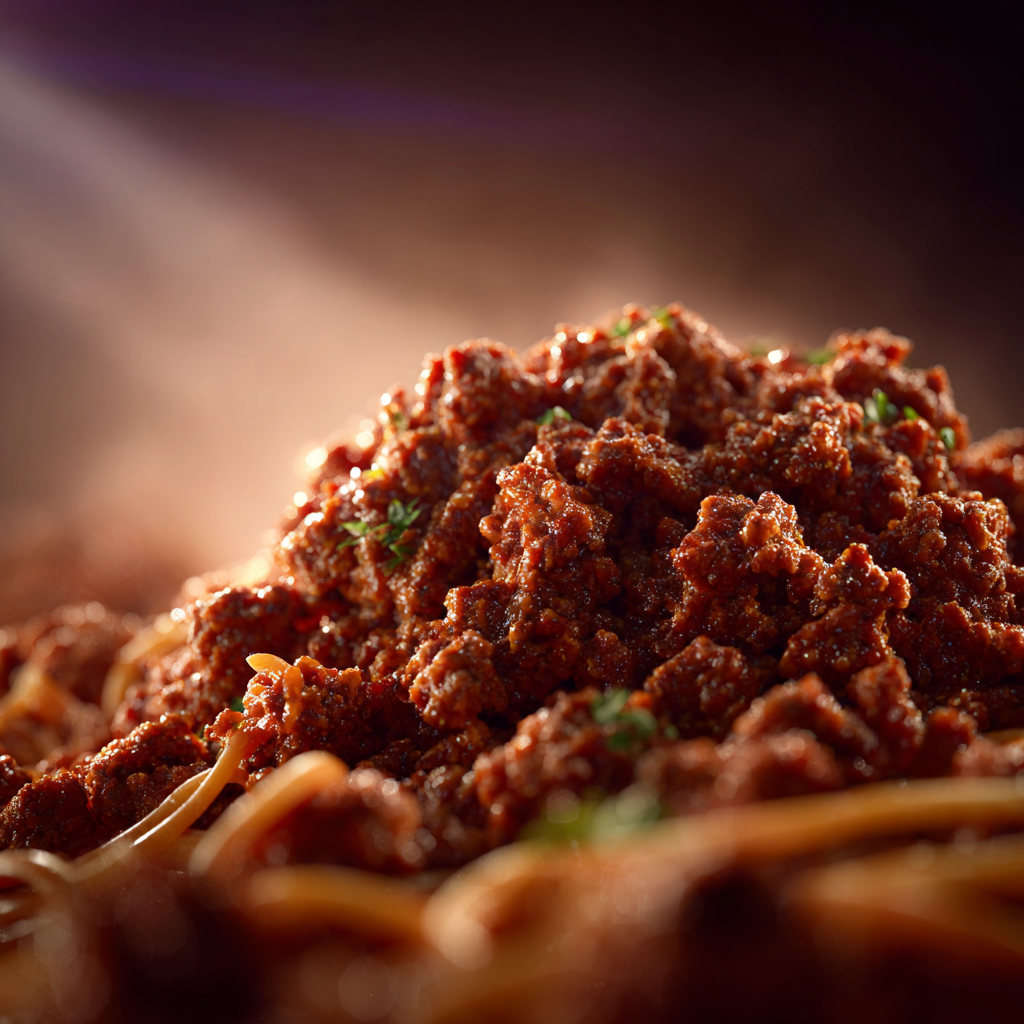 Pair your Bolognese with wine and sides for an Italian night
Pair your Bolognese with wine and sides for an Italian night
Pro Tip: If freezing, use flat freezer bags to save space and speed up defrosting.
This strategy is perfect if you’re feeding a crowd or prepping a few dinners ahead of time.
Batch Tip: Freeze extra portions in labeled bags with the date and number of servings. Pull one out on a busy night and dinner is done.
Pro Move: Brush your garlic bread with a little pasta water before toasting. It keeps it soft in the center and perfect for wiping plates clean.
Quick Fix: No time to bake? Grab store-bought biscotti and pair with sweet vermouth or dessert wine—it feels luxe with zero effort.
- A step-by-step recipe using beef and pork for perfect flavor balance
- Time-tested cooking tips for maximizing richness
- Real answers to common questions like “What makes an easy Bolognese recipe?”
- And insights into what sets apart a traditional spaghetti Bolognese recipe Gino-style from your average sauce
Table of Contents
- Ingredients Breakdown for the Best Spaghetti Bolognese Recipe
- Understanding the Traditional Ingredients in Spaghetti Bolognese
- The Secret Veggie Blend That Makes This Recipe Stand Out
- Choosing the Right Meats for an Authentic Beef Bolognese Recipe
- Red Wine vs. Beef Broth – Which Is Best?
- Why Milk Belongs in Bolognese
- Tomatoes and Seasonings – The Heart of Any Easy Bolognese Recipe
- The Pasta – Not Just Spaghetti
- Step-by-Step Instructions for Cooking the Perfect Spaghetti Bolognese Recipe
- Sautéing the Flavor Base – Where the Magic Begins
- Browning the Meats – Unlocking Umami in Your Spaghetti Bolognese Recipe
- Deglazing and Simmering – How to Build Depth in Your Spaghetti Bolognese Recipe
- Adding Tomatoes and Herbs – Turning Your Base into a Full Bolognese
- Preparing and Finishing the Pasta – Uniting Sauce and Spaghetti
- Pro Tips to Elevate Your Spaghetti Bolognese Recipe to the Next Level
- Simmer Low and Slow – The Key to a Traditional Spaghetti Bolognese Recipe
- Don’t Skip the Milk – The Secret Ingredient Pros Use
- Deglazing for Flavor Layers – Wine or Broth Done Right
- Choosing the Right Pasta – Don’t Just Default to Spaghetti
- Common Mistakes to Avoid in a Bolognese Sauce
- Custom Variations of the Spaghetti Bolognese Recipe for Every Lifestyle
- Making It a Healthy Bolognese Without Sacrificing Flavor
- Gluten-Free Spaghetti Bolognese That Tastes Just Like the Original
- How to Make a Dairy-Free Bolognese Sauce
- Gourmet Bolognese Upgrades Inspired by Michelin Star Chefs
- Kid-Friendly Spaghetti Bolognese Recipe That the Whole Family Loves
- Prep Like a Pro – Storing, Freezing, and Reheating Your Spaghetti Bolognese Recipe
- Why Bolognese Is Even Better the Next Day
- How to Store Bolognese Sauce for Maximum Freshness
- Reheating Without Ruining the Texture
- Prepping Pasta Ahead of Time – Yes, You Can!
- Batch Cooking for Busy Weeks
- Pasta Water Ice Cubes – Yes, It’s a Thing!
- Easy Desserts to End on a Sweet Note
- Unwrapping the Story Behind the Spaghetti Bolognese Recipe
- A Dish with Roots Deeper Than Its Name
- The Journey from Italy to the World’s Table
- How Chefs Like Jamie Oliver and Gino Reinvented the Classic
- Why the World Fell in Love with Bolognese
- FAQ – Everything You’ve Ever Wondered About Spaghetti Bolognese
- What is the most traditional spaghetti Bolognese recipe?
- Is there an easy Bolognese recipe for busy weeknights?
- What’s the difference between Bolognese sauce and other meat sauces?
- How does Jamie Oliver’s spaghetti Bolognese recipe compare?
- Watch How To Make Spaghetti Bolognese Recipe
Ingredients Breakdown for the Best Spaghetti Bolognese Recipe
Print
clock iconcutlery iconflag iconfolder iconinstagram iconpinterest iconfacebook iconprint iconsquares iconheart iconheart solid icon
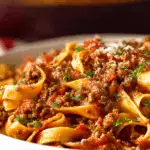




Disclosure: This post contains affiliate links.If you click and make a purchase, I may earn a small commission at no extra cost to you.

Milk Frother
Buy Now →

Meat Thermometer
Buy Now →

Olive Oil Sprayer
Buy Now →
How To Prepare Irresistible Spaghetti Bolognese Recipe
5 Stars 4 Stars 3 Stars 2 Stars 1 Star
No reviews
- Author: Olivia
- Total Time: 1 hour
- Yield: 4–6 servings
- Diet: Halal
Print Recipe
Pin Recipe
Description
Spaghetti Bolognese is a classic Italian dish featuring a rich and savory meat sauce made with ground beef, aromatic vegetables, tomatoes, and herbs, all served over al dente spaghetti. It’s hearty, flavorful, and perfect for cozy dinners or impressive entertaining.
Ingredients
- 2 tablespoons olive oil
- 1 onion, finely chopped
- 2 cloves garlic, minced
- 1 carrot, finely diced
- 1 celery stalk, finely diced
- 1 lb (450g) ground beef
- 1/4 cup tomato paste
- 1 can (28 oz) crushed tomatoes
- 1/2 cup red wine (optional)
- 1 teaspoon dried oregano
- 1/2 teaspoon dried basil
- Salt and pepper to taste
- 1/4 cup whole milk or cream
- 12 oz (340g) spaghetti
- Grated Parmesan cheese, for serving
- Fresh basil or parsley, for garnish
Cook Mode Prevent your screen from going dark
Instructions
- Heat olive oil in a large skillet or saucepan over medium heat. Add onion, carrot, and celery. Cook for 5–6 minutes until softened.
- Add garlic and cook for 1 minute more until fragrant.
- Add ground beef, breaking it apart with a spoon, and cook until browned. Drain excess fat if needed.
- Stir in tomato paste and cook for 2 minutes to develop flavor.
- Add crushed tomatoes, red wine (if using), oregano, basil, salt, and pepper. Stir well to combine.
- Reduce heat to low and simmer uncovered for 25–30 minutes, stirring occasionally, until thickened and rich.
- Stir in milk or cream and simmer for another 5 minutes. Adjust seasoning if needed.
- Meanwhile, cook spaghetti in salted boiling water until al dente. Drain well.
- Toss cooked spaghetti with some of the Bolognese sauce or plate the pasta and spoon sauce on top.
- Serve hot with grated Parmesan and garnish with fresh herbs.
Notes
- Use a mix of ground beef and pork for extra depth of flavor.
- Simmer longer (up to 1–2 hours) for a richer, more traditional ragu-style Bolognese.
- Leftover sauce freezes well for up to 3 months.
- Serve with garlic bread and salad for a complete meal.
- Prep Time: 15 minutes
- Cook Time: 45 minutes
- Category: Main Course
- Method: Stovetop
- Cuisine: Italian
Nutrition
- Serving Size: 1 plate
- Calories: 510
- Sugar: 7g
- Sodium: 580mg
- Fat: 20g
- Saturated Fat: 7g
- Unsaturated Fat: 11g
- Trans Fat: 0g
- Carbohydrates: 55g
- Fiber: 4g
- Protein: 28g
- Cholesterol: 60mg
Did you make this recipe?
Share a photo and tag us — we can’t wait to see what you’ve made!
Understanding the Traditional Ingredients in Spaghetti Bolognese
 Browning meat is the first key step in building deep flavor
A classic spaghetti Bolognese recipe is built from simple ingredients, but don’t let that fool you. When used correctly, each one adds depth and richness. Let’s start with the essentials.
Browning meat is the first key step in building deep flavor
A classic spaghetti Bolognese recipe is built from simple ingredients, but don’t let that fool you. When used correctly, each one adds depth and richness. Let’s start with the essentials.
- Olive Oil: This is your flavor base. Choose high-quality extra virgin olive oil for best results—it gives the sauce a beautiful, rounded mouthfeel.
- Yellow Onion: Finely diced onion brings a natural sweetness that helps mellow the acidity of the tomatoes. Cooking it gently in oil builds flavor right from the start.
- Garlic: Crushed garlic infuses the sauce with a warm, earthy aroma. Don’t rush it—let it soften without burning for a mellow finish.
The Secret Veggie Blend That Makes This Recipe Stand Out
One reason this traditional spaghetti Bolognese recipe works so well is the mirepoix: carrot, celery, and onion. Together, they form a flavor base that brings balance and body to the meat sauce.- Carrot: It’s not just filler—it adds natural sweetness and color to the sauce.
- Celery: Subtle but critical, celery brings a fresh, almost herbal undertone that cuts through the richness.
- Why Finely Dicing Matters: Uniformly chopped vegetables cook evenly and disappear into the sauce for that signature smooth texture.
Choosing the Right Meats for an Authentic Beef Bolognese Recipe
The backbone of any Bolognese sauce is the meat—and in our recipe, we use both ground beef and pork to hit that perfect umami note.| Meat Type | Role in Flavor |
|---|---|
| Lean Ground Beef | Provides hearty, savory base |
| Ground Pork | Adds tenderness and just enough fat for a silky texture |
Red Wine vs. Beef Broth – Which Is Best?
Wine in Bolognese is traditional, but if you’re cooking for kids or prefer to avoid alcohol, beef broth is a great substitute.- Red Wine: Deepens flavor, adds acidity, and elevates the overall sauce profile.
- Beef Broth: Still brings umami, just without the sharp edges of wine.
Why Milk Belongs in Bolognese
Many first-timers are surprised by this one, but milk is a must. It balances acidity, tenderizes the meat, and gives that signature creamy note.- Pro Tip: Let the milk simmer slowly before adding tomatoes—this locks in richness and prevents curdling.
Tomatoes and Seasonings – The Heart of Any Easy Bolognese Recipe
We use both whole canned tomatoes and tomato paste in our sauce for a deep, slow-cooked flavor.- Whole Tomatoes: Preferably San Marzano or high-quality plum tomatoes. Crush them with a spoon as they cook.
- Tomato Paste: Adds thickness and a concentrated tomato punch.
- Italian Seasoning & Bay Leaf: These herbs build complexity and hint at rustic Italian charm.
The Pasta – Not Just Spaghetti
While most folks default to spaghetti, pappardelle or tagliatelle are traditional to the Bolognese region of Italy. That said, we stick with spaghetti here for familiarity and availability—but feel free to mix it up.- Pro Tip: Save some of the pasta water. Its starch helps the sauce cling to the noodles for that pro finish.
Step-by-Step Instructions for Cooking the Perfect Spaghetti Bolognese Recipe

Sautéing the Flavor Base – Where the Magic Begins
The first step in creating a memorable spaghetti Bolognese recipe is developing a rich flavor base. This is where the olive oil, onion, garlic, carrot, and celery come together.
- Heat olive oil over medium heat in a large, heavy-bottomed pot. A Dutch oven works best for even heat distribution.
- Add the finely diced yellow onion and cook until translucent—around 3 to 4 minutes.
- Toss in the crushed garlic, carrot, and celery. Stir occasionally and cook for about 5 more minutes. You’re looking for softness, not browning.
Browning the Meats – Unlocking Umami in Your Spaghetti Bolognese Recipe
Every unforgettable spaghetti Bolognese recipe begins with this—browning the meat to coax out that deep, savory flavor known as umami. It’s not just about cooking beef and pork; it’s about building the backbone of your sauce. Start by heating your pot over medium-high heat. Add ground beef and ground pork—two essential components of a hearty spaghetti Bolognese recipe. Break the meat up with a wooden spoon, stirring frequently to avoid clumping. You want small, even crumbles. Cook until no pink remains, about 8 to 10 minutes. This step in your spaghetti Bolognese recipe is where the transformation begins. As the meat browns, it releases fats and creates fond—the crispy, caramelized bits on the bottom of the pan that flavor chefs dream of. Once browned, drain most of the fat, leaving just a touch. That bit of richness? It’s the secret weapon of any great spaghetti Bolognese recipe, giving the sauce a silky, restaurant-quality finish without being greasy.Deglazing and Simmering – How to Build Depth in Your Spaghetti Bolognese Recipe
With your meat browned to perfection, it’s time to bring your spaghetti Bolognese recipe to life with liquid flavor layers. Pour in red wine—or beef broth if you prefer non-alcoholic—and begin the deglazing magic. Use your spoon to scrape up every browned bit from the pot. This, right here, is how a proper spaghetti Bolognese recipe builds complexity. As the wine or broth reduces, the flavors become concentrated, fusing into the meat. Let the liquid simmer uncovered for about 10 minutes. You’ll notice the mixture thickening—a key sign your spaghetti Bolognese recipe is progressing beautifully. Now, pour in whole milk. Yes, milk. This might surprise some, but in a traditional spaghetti Bolognese recipe, milk is crucial. It mellows the acidity from the tomatoes and transforms the texture of the meat into something tender and luxurious. Allow the milk to simmer for another 8 minutes until mostly absorbed. What you’re doing here isn’t just simmering—you’re layering. A true spaghetti Bolognese recipe is built, not tossed together. This double-simmer method is what separates an average dish from a Michelin star–level spaghetti Bolognese recipe.Adding Tomatoes and Herbs – Turning Your Base into a Full Bolognese
Here’s the turning point: when your sauce goes from meat-heavy to fully evolved spaghetti Bolognese recipe brilliance. Stir in a 28-ounce can of whole tomatoes with juice. These should be high-quality—San Marzano if you can find them. Add in 4 tablespoons of rich tomato paste, a teaspoon of Italian seasoning, and one bay leaf. These ingredients breathe aroma and soul into your spaghetti Bolognese recipe. Break up the whole tomatoes with a spoon, or crush them by hand before they hit the pot. Smooth or chunky—it’s your call. Stir everything thoroughly and bring the mixture to a gentle simmer. Now cover, reduce heat, and let the sauce cook slowly for at least 30 minutes. This is where your spaghetti Bolognese recipe finds its voice. Stir occasionally to prevent sticking and ensure even flavor distribution. Once the sauce has thickened and darkened slightly, taste. Season with salt and pepper as needed. These final adjustments elevate your spaghetti Bolognese recipe from good to unforgettable.Preparing and Finishing the Pasta – Uniting Sauce and Spaghetti
Now for the grand finale. Bring a pot of salted water to a rolling boil. Add your spaghetti—or another long pasta like pappardelle—and cook it to al dente. Remember, the pasta is just as vital to your spaghetti Bolognese recipe as the sauce. Before draining, reserve 1½ cups of pasta water. It may seem like a small step, but it’s essential to completing your spaghetti Bolognese recipe. That starchy water will help your sauce bind perfectly to the pasta. Drain the noodles and transfer them straight into your sauce pot. This is the moment where your spaghetti Bolognese recipe comes together—sauce and pasta marrying into one comforting, flavorful creation. Add reserved pasta water a little at a time as you toss. This keeps the consistency perfect and allows your spaghetti Bolognese recipe to coat every strand evenly. Serve piping hot with grated parmesan and a few basil leaves if desired. And just like that, you’ve crafted a rich, aromatic, satisfying spaghetti Bolognese recipe from scratch—one that doesn’t just fill the stomach, but nourishes the soul.s. Want more pasta inspiration? Check out this delicious garlic butter mushroom linguine for a creamy, herb-forward twist on Italian comfort.Pro Tips to Elevate Your Spaghetti Bolognese Recipe to the Next Level
 Store and freeze your Bolognese for quick weekday meals
Store and freeze your Bolognese for quick weekday meals
Simmer Low and Slow – The Key to a Traditional Spaghetti Bolognese Recipe
One of the hallmarks of a truly traditional spaghetti Bolognese recipe is the slow simmer. Rushing this process sacrifices depth and texture.- Low heat is critical—keep it at a gentle bubble.
- Simmer for at least 30 minutes, but up to 90 minutes if you have the time.
- Stir occasionally and scrape the bottom to prevent scorching.
Don’t Skip the Milk – The Secret Ingredient Pros Use
Milk isn’t just tradition—it’s transformation. A Michelin star Bolognese recipe always includes dairy. Why?- Milk tenderizes the meat, preventing it from becoming rubbery.
- It softens acidity from the tomatoes.
- It creates that velvety finish you taste in high-end restaurants.
Deglazing for Flavor Layers – Wine or Broth Done Right
Deglazing with red wine (or broth) isn’t just a step—it’s where flavor explodes.- Always simmer uncovered to allow alcohol or liquid to reduce.
- Don’t rush this part. Let the sauce absorb all that flavor.
Choosing the Right Pasta – Don’t Just Default to Spaghetti
Yes, we call it spaghetti Bolognese, but truthfully, this sauce shines with pappardelle, fettuccine, or tagliatelle.| Pasta Type | Sauce Grip Rating |
|---|---|
| Spaghetti | Good |
| Fettuccine | Better |
| Pappardelle | Best |
Common Mistakes to Avoid in a Bolognese Sauce
Even the most easy Bolognese recipe can fall flat if these common mistakes sneak in:- Overcooking the garlic – burns easily, tastes bitter.
- Using only beef – lacks the balance that pork brings.
- Too much tomato paste – leads to overpowering acidity.
- Not reserving pasta water – crucial for adjusting sauce consistency.
- Serving too soon – sauce needs time to sit for best results.
Custom Variations of the Spaghetti Bolognese Recipe for Every Lifestyle
 Pair your Bolognese with wine and sides for an Italian night
Pair your Bolognese with wine and sides for an Italian night
Making It a Healthy Bolognese Without Sacrificing Flavor
If you’re aiming for a lighter meal, don’t worry—this spaghetti Bolognese recipe is easy to adapt for a healthier lifestyle.- Swap ground pork with ground turkey or chicken for lower fat.
- Use whole-wheat spaghetti or legume pasta for added fiber and protein.
- Cut down on the olive oil by half if watching calories.
- Use low-sodium beef broth in place of wine to reduce salt content.
Gluten-Free Spaghetti Bolognese That Tastes Just Like the Original
Gluten-free eaters can enjoy the full experience of this hearty dish with just a few tweaks:- Choose a sturdy gluten-free pasta, such as rice or quinoa-based varieties.
- Confirm your tomato paste and broth are labeled gluten-free.
- Opt for fresh grated cheese (pre-shredded often contains anti-caking agents with gluten).
How to Make a Dairy-Free Bolognese Sauce
For lactose-free or vegan diners, removing the milk doesn’t mean compromising taste:- Substitute with unsweetened almond, oat, or soy milk—they offer the creaminess without dairy.
- Skip cheese or use plant-based parmesan alternatives when serving.
- Want it entirely plant-based? Try lentils or mushrooms as a meat replacement.
Gourmet Bolognese Upgrades Inspired by Michelin Star Chefs
If you’re aiming to impress, these Michelin-inspired upgrades will take your beef Bolognese recipe from home-cooked to five-star:- Finish the sauce with a pat of butter and splash of cream just before serving.
- Add finely minced pancetta with the onions for added depth.
- Stir in a pinch of nutmeg or cinnamon—Italian chefs swear by it.
- Serve with fresh egg pasta and drizzle a touch of truffle oil on top.
Kid-Friendly Spaghetti Bolognese Recipe That the Whole Family Loves
To make it more appealing to younger eaters:- Finely chop or blend the veggies so they disappear into the sauce.
- Use ground chicken or turkey if your kids prefer milder flavors.
- Skip the wine and use beef broth only.
- Keep seasoning mild, and let them sprinkle their own cheese.
Prep Like a Pro – Storing, Freezing, and Reheating Your Spaghetti Bolognese Recipe
Why Bolognese Is Even Better the Next Day
You know how some dishes taste better the next day? Well, spaghetti Bolognese recipe is a textbook example. The reason? Time.- As the sauce rests overnight, the flavors mingle and deepen.
- The richness balances out.
- The herbs and aromatics settle into a warm harmony.
How to Store Bolognese Sauce for Maximum Freshness
Keep your hard work tasting like it was just made. Follow this table for quick storage tips:| Storage Method | How to Store | Shelf Life | Best Use |
|---|---|---|---|
| Fridge (Short-Term) | Airtight container, fully cooled | 3–4 days | Reheat for lunch or dinner |
| Freezer (Long-Term) | Portion in freezer bags or containers | Up to 3 months | Perfect for batch cooking |
| Refrigerated with Pasta | Tossed with pasta in sealed container | 2 days | For quick reheat & serve |
Reheating Without Ruining the Texture
One of the most common Bolognese mistakes? Overcooking during reheating. That leads to a dry, broken sauce. Avoid it with these tips:- Microwave: Add a tablespoon of water or broth, cover with a damp paper towel, and heat in 1-minute bursts. Stir between each.
- Stovetop: Place sauce in a saucepan with a splash of pasta water or milk. Warm over medium-low heat, stirring gently until heated through.
Prepping Pasta Ahead of Time – Yes, You Can!
Cooking pasta in advance? Yes—it can be done without sacrificing that satisfying bite.| Step | Details |
|---|---|
| Cook Pasta | 1–2 minutes less than al dente |
| Cool | Rinse with cold water and toss with olive oil |
| Store | Keep in a zip-top bag or airtight container |
| Use | Reheat by tossing into boiling water for 30 seconds before serving |
Batch Cooking for Busy Weeks
One of the best things about this easy Bolognese recipe is how effortlessly it scales. Here’s how to double or triple the recipe like a pro:| Ingredient | Standard Batch | Double Batch | Triple Batch |
|---|---|---|---|
| Olive Oil | 2 tbsp | 4 tbsp | 6 tbsp |
| Onion | 1 | 2 | 3 |
| Garlic | 4 cloves | 8 cloves | 12 cloves |
| Carrot | 1 | 2 | 3 |
| Celery | 1 rib | 2 ribs | 3 ribs |
| Ground Beef | 1 lb | 2 lbs | 3 lbs |
| Ground Pork | ½ lb | 1 lb | 1½ lbs |
| Tomatoes (Canned) | 1 (28 oz) | 2 cans | 3 cans |
| Tomato Paste | 4 tbsp | 8 tbsp | 12 tbsp |
| Milk | 1 cup | 2 cups | 3 cups |
| Red Wine/Broth | 1¼ cups | 2½ cups | 3¾ cups |
Pasta Water Ice Cubes – Yes, It’s a Thing!
One creative hack: freeze leftover pasta water in ice cube trays. Toss a cube into your reheated Bolognese or into any future pasta dish to revive texture and help sauce bind. Trust us, it’s an insider trick used by chefs—and now, by you. traditional spaghetti Bolognese recipe into a full Italian-style dinner, pair it with sides that don’t compete—but complement. Top 5 Side Dishes to Serve with Bolognese| Side Dish | Description |
|---|---|
| Garlic Bread | Crunchy, buttery, and ready to sop up sauce |
| Caesar Salad | Crisp romaine, creamy dressing, a tangy contrast |
| Roasted Veggies | Zucchini, bell peppers, or asparagus for freshness |
| Caprese Salad | Tomatoes, mozzarella, and basil—simple but elegant |
| Antipasto Skewers | Mini sticks with olives, meats, and cheeses for a touch of class |
Easy Desserts to End on a Sweet Note
Don’t stop the deliciousness at the last forkful of pasta. After a hearty Bolognese sauce, light and classic Italian desserts work best.| Dessert | Flavor Pairing |
|---|---|
| Tiramisu | Creamy, coffee-soaked layers to contrast savory notes |
| Affogato | Vanilla gelato “drowned” in espresso—light and elegant |
| Panna Cotta | Silky and simple, often infused with vanilla or citrus |
| Lemon Sorbet | Bright and refreshing; cuts through the richness |
| Biscotti with Wine | Crunchy almond cookies dipped in dessert wine |
Unwrapping the Story Behind the Spaghetti Bolognese Recipe
A Dish with Roots Deeper Than Its Name
At first glance, “spaghetti Bolognese recipe” sounds like something straight out of Bologna’s heart. But truth be told, that title’s a bit of a modern invention. In Bologna, Italy—the very city that inspired the name—the dish isn’t actually served with spaghetti at all. In traditional Bolognese kitchens, the sauce is known as Ragù alla Bolognese, and it’s typically paired with tagliatelle, a wide, ribbon-like pasta designed to grip onto the hearty, slow-cooked meat sauce. The classic Bolognese was never about tomatoes or garlic overload—it was a rustic, subtly layered dish made with finely chopped meats, vegetables, milk, and just a whisper of tomato. It simmered slowly for hours, soaking up flavors as it thickened and mellowed. The idea of pairing this sauce with spaghetti? That came much later.The Journey from Italy to the World’s Table
When Italians immigrated across Europe, to America, Australia, and beyond, they brought their flavors with them—but not always their ingredients. In places where tagliatelle was hard to find, spaghetti filled the gap. It was cheap, accessible, and cooked quickly—perfect for busy families trying to hold onto tradition in a new world. Over time, the Bolognese recipe was reshaped by different cultures, evolving into the globally beloved dish we now associate with comfort food. Each version tells a different story:- British cooks often leaned into tomatoes and red wine, giving the dish more acidity and boldness.
- American variations included extra garlic, dried herbs, and even sugar.
- In Australia, it’s not uncommon to find Bolognese with a splash of cream and a dusting of cheddar on top.
How Chefs Like Jamie Oliver and Gino Reinvented the Classic
Modern chefs have added their own spins too. Jamie Oliver’s spaghetti Bolognese recipe often includes fragrant herbs, a splash of balsamic vinegar, and rustic flair—crafted for simplicity and flavor. His method focuses on balance—never too rich, never too sharp. Meanwhile, Gino D’Acampo, a proud voice of traditional Italian cooking, champions a more classic take. His traditional spaghetti Bolognese recipe leans on pancetta for depth and precise layering of ingredients to build complexity without fuss. Others, chasing Michelin stars, have elevated the dish into gourmet territory. They infuse the sauce with bone marrow, slow-roasted tomatoes, or dry-aged beef. They finish it with truffle shavings or red wine reductions. Yet at its core, even the fanciest version is built on the foundation laid down by humble Italian home cooks.Why the World Fell in Love with Bolognese
This dish isn’t just dinner—it’s memory. It’s the smell that draws people to the kitchen. It’s the sauce that splatters your apron. It’s the second helping you weren’t planning on. People love spaghetti Bolognese because it’s forgiving, flexible, and full of soul. It’s a dish that holds space for creativity without letting go of its roots. Whether you simmer it all day or whip it up on a weeknight, it always delivers. Even if your ingredients aren’t exact or your pasta isn’t traditional, that doesn’t matter. What matters is that it brings comfort, flavor, and the feeling that you’re home—wherever that may be.FAQ – Everything You’ve Ever Wondered About Spaghetti Bolognese
What is the most traditional spaghetti Bolognese recipe?
A truly traditional spaghetti Bolognese recipe doesn’t actually start with spaghetti. In its birthplace, Bologna, it’s known as Ragù alla Bolognese and traditionally paired with fresh egg tagliatelle. The original recipe uses finely chopped beef and pork, simmered with onion, celery, and carrot, enriched with milk, a hint of tomato, and slowly cooked for hours.
Is there an easy Bolognese recipe for busy weeknights?
Absolutely. A good easy Bolognese recipe trims the cooking time without sacrificing too much depth. Instead of a slow, multi-hour simmer, you can use high-quality canned tomatoes, pre-chopped mirepoix (onion, celery, carrot), and a fast-reducing wine or broth.
Craving something bold and spicy after mastering Bolognese? Don’t miss this flavorful Cajun honey butter chicken pasta.
What’s the difference between Bolognese sauce and other meat sauces?
Bolognese sauce stands out because it’s more than just a meat-and-tomato combo. Unlike American-style meat sauces, which lean heavily on marinara or crushed tomatoes, Bolognese is meat-forward, creamy, and more nuanced.
It contains:
Ground beef and pork
Milk or cream
Minimal tomato (sometimes just paste)
A slow-cooked, dense texture
How does Jamie Oliver’s spaghetti Bolognese recipe compare?
The spaghetti Bolognese recipe Jamie Oliver shares with the world is rustic, hearty, and tweaked for flavor impact. Jamie often adds fresh herbs like rosemary or thyme, uses free-range minced meat, and sometimes sneaks in chopped bacon or even Worcestershire sauce for a little umami boost.
He embraces boldness—without losing sight of simplicity. His approach appeals to modern cooks who want depth without endless simmering. It’s a bridge between old-school comfort and current-day kitchen efficiency.
Watch How To Make Spaghetti Bolognese Recipe
Content retrieved from: https://recipestasteful.com/spaghetti-bolognese-recipe/.
















